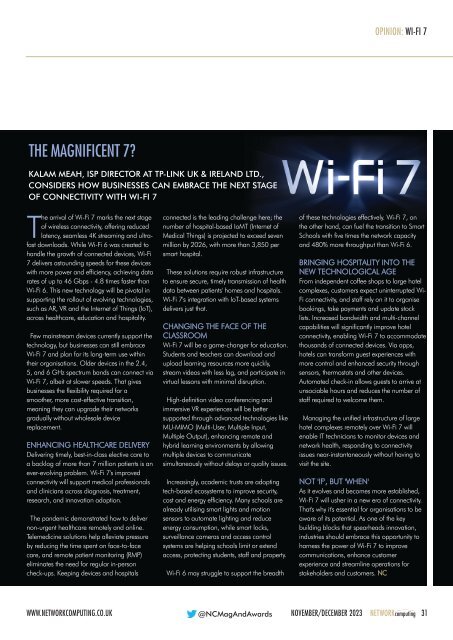NC Nov-Dec 2023
You also want an ePaper? Increase the reach of your titles
YUMPU automatically turns print PDFs into web optimized ePapers that Google loves.
OPINION: WI-FI 7<br />
THE MAGNIFICENT 7?<br />
KALAM MEAH, ISP DIRECTOR AT TP-LINK UK & IRELAND LTD.,<br />
CONSIDERS HOW BUSINESSES CAN EMBRACE THE NEXT STAGE<br />
OF CONNECTIVITY WITH WI-FI 7<br />
The arrival of Wi-Fi 7 marks the next stage<br />
of wireless connectivity, offering reduced<br />
latency, seamless 4K streaming and ultrafast<br />
downloads. While Wi-Fi 6 was created to<br />
handle the growth of connected devices, Wi-Fi<br />
7 delivers astounding speeds for these devices<br />
with more power and efficiency, achieving data<br />
rates of up to 46 Gbps - 4.8 times faster than<br />
Wi-Fi 6. This new technology will be pivotal in<br />
supporting the rollout of evolving technologies,<br />
such as AR, VR and the Internet of Things (IoT),<br />
across healthcare, education and hospitality.<br />
Few mainstream devices currently support the<br />
technology, but businesses can still embrace<br />
Wi-Fi 7 and plan for its long-term use within<br />
their organisations. Older devices in the 2.4,<br />
5, and 6 GHz spectrum bands can connect via<br />
Wi-Fi 7, albeit at slower speeds. That gives<br />
businesses the flexibility required for a<br />
smoother, more cost-effective transition,<br />
meaning they can upgrade their networks<br />
gradually without wholesale device<br />
replacement.<br />
ENHA<strong>NC</strong>ING HEALTHCARE DELIVERY<br />
Delivering timely, best-in-class elective care to<br />
a backlog of more than 7 million patients is an<br />
ever-evolving problem. Wi-Fi 7's improved<br />
connectivity will support medical professionals<br />
and clinicians across diagnosis, treatment,<br />
research, and innovation adoption.<br />
The pandemic demonstrated how to deliver<br />
non-urgent healthcare remotely and online.<br />
Telemedicine solutions help alleviate pressure<br />
by reducing the time spent on face-to-face<br />
care, and remote patient monitoring (RMP)<br />
eliminates the need for regular in-person<br />
check-ups. Keeping devices and hospitals<br />
connected is the leading challenge here; the<br />
number of hospital-based IoMT (Internet of<br />
Medical Things) is projected to exceed seven<br />
million by 2026, with more than 3,850 per<br />
smart hospital.<br />
These solutions require robust infrastructure<br />
to ensure secure, timely transmission of health<br />
data between patients' homes and hospitals.<br />
Wi-Fi 7's integration with IoT-based systems<br />
delivers just that.<br />
CHANGING THE FACE OF THE<br />
CLASSROOM<br />
Wi-Fi 7 will be a game-changer for education.<br />
Students and teachers can download and<br />
upload learning resources more quickly,<br />
stream videos with less lag, and participate in<br />
virtual lessons with minimal disruption.<br />
High-definition video conferencing and<br />
immersive VR experiences will be better<br />
supported through advanced technologies like<br />
MU-MIMO (Multi-User, Multiple Input,<br />
Multiple Output), enhancing remote and<br />
hybrid learning environments by allowing<br />
multiple devices to communicate<br />
simultaneously without delays or quality issues.<br />
Increasingly, academic trusts are adopting<br />
tech-based ecosystems to improve security,<br />
cost and energy efficiency. Many schools are<br />
already utilising smart lights and motion<br />
sensors to automate lighting and reduce<br />
energy consumption, while smart locks,<br />
surveillance cameras and access control<br />
systems are helping schools limit or extend<br />
access, protecting students, staff and property.<br />
Wi-Fi 6 may struggle to support the breadth<br />
of these technologies effectively. Wi-Fi 7, on<br />
the other hand, can fuel the transition to Smart<br />
Schools with five times the network capacity<br />
and 480% more throughput than Wi-Fi 6.<br />
BRINGING HOSPITALITY INTO THE<br />
NEW TECHNOLOGICAL AGE<br />
From independent coffee shops to large hotel<br />
complexes, customers expect uninterrupted Wi-<br />
Fi connectivity, and staff rely on it to organise<br />
bookings, take payments and update stock<br />
lists. Increased bandwidth and multi-channel<br />
capabilities will significantly improve hotel<br />
connectivity, enabling Wi-Fi 7 to accommodate<br />
thousands of connected devices. Via apps,<br />
hotels can transform guest experiences with<br />
more control and enhanced security through<br />
sensors, thermostats and other devices.<br />
Automated check-in allows guests to arrive at<br />
unsociable hours and reduces the number of<br />
staff required to welcome them.<br />
Managing the unified infrastructure of large<br />
hotel complexes remotely over Wi-Fi 7 will<br />
enable IT technicians to monitor devices and<br />
network health, responding to connectivity<br />
issues near-instantaneously without having to<br />
visit the site.<br />
NOT 'IF', BUT 'WHEN'<br />
As it evolves and becomes more established,<br />
Wi-Fi 7 will usher in a new era of connectivity.<br />
That's why it's essential for organisations to be<br />
aware of its potential. As one of the key<br />
building blocks that spearheads innovation,<br />
industries should embrace this opportunity to<br />
harness the power of Wi-Fi 7 to improve<br />
communications, enhance customer<br />
experience and streamline operations for<br />
stakeholders and customers. <strong>NC</strong><br />
WWW.NETWORKCOMPUTING.CO.UK NOVEMBER/DECEMBER <strong>2023</strong> 31<br />
NETWORKcomputing<br />
@<strong>NC</strong>MagAndAwards
















